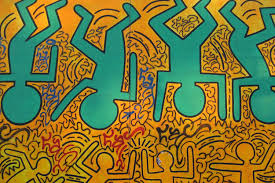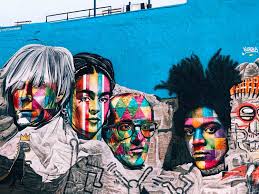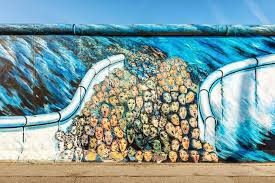History of Street Art – The Ancient Foundations of Public Mark-Making
The history of street art, in its broadest sense, begins with humanity’s earliest impulses to mark public spaces. Long before the invention of the spray can, our ancestors used the walls of caves as their canvas. The stunning depictions of bison, horses, and human hands in places like Lascaux, France, and Altamira, Spain, were not merely decorative; they were profound expressions of belief, ritual, and a desire to communicate with a community. These ancient works, created over 17,000 years ago, share a fundamental DNA with modern street art: they are public, accessible, and created outside the formal structures of a gallery or museum.

Moving forward through time, examples of public art as social and political commentary abound across ancient civilizations. In the Roman Empire, citizens scratched political slogans and advertisements onto walls in Pompeii. In ancient Egypt and Greece, artisans carved intricate reliefs and statues into the sides of temples and public buildings, telling stories of gods, pharaohs, and military victories to an often illiterate populace. These acts were the precursors to the modern mural, using public space to reinforce power structures, share cultural narratives, and communicate with the masses. This demonstrates that the history of street art is deeply intertwined with the history of public communication itself.
Street Art Gallery Museum by PausSlot
Even the use of “tags” or personal signatures has ancient parallels. The Vikings carved runic inscriptions, known as runestones, to commemorate the dead, boast of their travels, or mark territory. Similarly, legionnaires stationed at Hadrian’s Wall in Britain carved their names and symbols into the stone, a simple proclamation: “I was here.” This primal need to assert one’s existence and identity in a public forum is a continuous thread that runs directly into the heart of 20th-century graffiti culture, forming a foundational chapter in the long and varied history of street art.
History of Street Art – The Birth of Modern Graffiti in the 20th Century
The direct lineage of contemporary street art is most often traced to the late 1960s and early 1970s in the United States, specifically to the urban landscape of Philadelphia and New York City. The modern movement began not with elaborate murals, but with simple “tagging.” In Philadelphia, writers like Cornbread and Cool Earl gained notoriety for spreading their nicknames across the city. However, it was in New York, particularly in the Washington Heights neighborhood and the borough of the Bronx, that this new art form truly exploded and began its critical evolution.
The catalyst for this explosion was the proliferation of the aerosol spray paint can. Originally developed for commercial and industrial use, the spray can became the tool of choice for a generation of young artists. Its portability, speed, and the unique quality of its mark made it perfect for the fast, illegal work of writing on subway trains and city walls. The New York City subway system became the primary canvas for this new movement. Writers like TAKI 183, a Greek-American teenager from Washington Heights, became famous for his ubiquitous tag, which was spotted on trains that traveled throughout all five boroughs, making his name known citywide.
This “tagging” was a game of fame and visibility, driven by the competitive spirit of the writers. The goal was to get your name “up” in as many places as possible, with style and quantity being the measures of success. This competitive energy fueled rapid innovation, leading from simple tags to more elaborate “throw-ups” (bubble letters) and eventually to complex, multi-colored “pieces” (masterpieces). This era laid the essential groundwork for the entire movement, establishing the culture, the tools, and the aesthetic foundations upon which the later, more diverse history of street art would be built.
History of Street Art – The Evolution from Tags to Masterpieces in the 1970s and 80s

As the history of street art graffiti movement matured throughout the 1970s, the simple tag was no longer enough for the most ambitious writers. The competition for fame pushed artists to develop more complex and visually stunning works. The “throw-up,” a quickly executed piece typically involving two colors and bubble letters, became a way to cover more space more efficiently than a tag. But the true artistic leap came with the “masterpiece,” or “piece,” which was a large, intricate, and multi-colored production that often took hours to complete.
This period saw the formation of dedicated “crews,” groups of writers who worked together, such as the Fabulous Five, the Soul Artists, and the legendary Wild Style crew. These crews pooled resources, provided lookouts, and collaborated on large-scale pieces, pushing the art form to new levels of technical proficiency and artistic ambition. The trains of New York became rolling galleries, showcasing vibrant, dynamic, and highly stylized lettering that was often indecipherable to the uninitiated but represented the pinnacle of achievement within the subculture.
The early 1980s marked the peak of the “subway era” and its subsequent decline due to the Metropolitan Transportation Authority’s (MTA) increasingly aggressive anti-graffiti campaign. The documentary “Style Wars” (1983) and the book “Subway Art” (1984) immortalized this golden age, capturing the energy, artistry, and social context of the movement just as it was being forced above ground. These works were crucial in documenting and disseminating the culture, ensuring that the history of street art would preserve this vital, explosive period of innovation and providing inspiration for a new generation of artists around the world.
History of Street Art – Street Art Diversifies: Stencils, Posters, and Stickering
As the crackdown on subway graffiti intensified in the 1980s and 90s, the art form began to evolve and diversify beyond spray-painted lettering. Artists started to adopt new techniques that were faster, more reproducible, and often carried a more direct political or social message. The stencil emerged as a powerful tool, popularized by artists like Blek le Rat in Paris. Using stencils allowed for the rapid replication of an image, enabling an artist to hit multiple locations in a single night with a consistent, graphic signature.
This period marked a significant shift in the history of street art, as the focus began to expand from the writer’s name to a broader conceptual or illustrative message. Artists began using wheat-paste posters, which could be pre-made in the studio and then quickly applied to walls with a brush and adhesive. Stickering also became a popular and accessible medium. These methods lowered the barrier to entry and allowed for a wider range of artistic expression, including photorealism, illustration, and graphic design, to enter the public sphere.
This diversification was critical in the globalization of the movement. The imagery used in stencils and posters was often more universally understandable than the stylized letterforms of New York graffiti. A stenciled rat or a pasted portrait could communicate an idea across language barriers. This allowed the history of street art to branch out from its American roots and flourish in cities across Europe, South America, and Australia, with local artists adapting the form to comment on their own unique social and political contexts.
History of Street Art – The Rise of the Mural and Large-Scale Public Art
Parallel to the underground, often illegal world of graffiti, a separate but related tradition of the community mural was gaining momentum. Since the 1960s, organizations had been commissioning large-scale public paintings, often with social or political themes, to beautify neighborhoods and empower communities. This “legitimate” strand of public art began to merge with the energy and aesthetics of the graffiti and street art movement in the 1990s and 2000s, leading to a new era of monumental urban art.
Artists who had honed their skills illegally began to receive commissions from businesses, city governments, and private clients to create large, legal murals. This shift had a profound impact on the history of street art, as it provided artists with financial support, more time to create, and a new level of public legitimacy. The scale of these works transformed the visual landscape of cities, turning blank, often dilapidated walls into breathtaking points of civic pride and tourist attraction.
This era saw the rise of artists whose work was defined by its monumental scale and technical brilliance. Murals by artists like BLU in Italy, Os Gêmeos in Brazil, and Shepard Fairey in the US became iconic landmarks. The aesthetic shifted from text-based works to figurative, character-driven, and often surreal or hyper-realistic imagery. This acceptance of the mural format played a crucial role in rebranding “vandalism” as “urban regeneration,” a contentious but pivotal moment in the mainstream acceptance of the art form.
History of Street Art – The Influence of Pop Culture and Commercialization

As street art gained visibility and cultural cachet, it inevitably intersected with the worlds of pop culture and commerce. This relationship has been one of the most complex and debated aspects of its recent history. On one hand, commercial success offered artists a sustainable career path and a much wider platform for their work. On the other hand, it raised difficult questions about authenticity, co-option, and the movement’s anti-establishment roots.
The turning point is widely considered to be the rise of the artist Banksy. His clever, politically charged stencils, combined with his enigmatic identity, captured the global imagination in the early 2000s. Banksy’s work made street art accessible and fascinating to the general public and the mainstream media in an unprecedented way. His success demonstrated that there was a massive market for this type of art, leading to lucrative gallery shows, book deals, and a frenzy of media attention that transformed the scene.
This commercial boom had a dual effect. It created a new class of art-market darlings and led to collaborations between street artists and major brands like Nike, Coca-Cola, and Louis Vuitton. While this provided financial opportunity, it also sparked intense criticism from purists who saw it as a betrayal of the movement’s subversive spirit. The history of street art now had to contend with its own success, navigating the tricky path between maintaining its critical edge and embracing the opportunities of the mainstream market.
History of Street Art – The Digital Revolution and Global Proliferation
The advent of the internet and the rise of social media in the 21st century fundamentally altered the trajectory and dissemination of street art. Before the digital age, knowledge of the scene was largely local or spread through niche magazines and documentaries. With the launch of platforms like Flickr, and later Instagram and Pinterest, a artist in São Paulo could instantly see a piece created in Melbourne, and vice versa. This created a global, interconnected conversation.
Websites like Wooster Collective, founded in 2003, became vital online hubs, curating and documenting street art from every corner of the globe. This digital archive democratized the history of street art, making it a living, constantly updated record. For artists, social media became a new, virtual wall. They could now share their work directly with a global audience of millions, bypassing traditional gatekeepers like galleries and museums. A piece that might be painted over in hours could achieve immortality and viral status online.
This digital proliferation accelerated the cross-pollination of styles and ideas, leading to a more homogenized but also more diverse global aesthetic. It also changed the nature of fame within the scene; an artist could now build an international reputation without ever leaving their hometown. The digital revolution ensured that the history of street art would no longer be written solely in physical public spaces, but also in the vast, interconnected digital realm, forever changing how the art is created, shared, and consumed.
History of Street Art – Street Art Enters the Institutional Halls: Museums and Galleries
The ultimate sign of street art’s cultural ascendance has been its acceptance into the very institutions it was once defined against: museums and auction houses. Beginning in the 2000s, major cultural institutions began to mount exhibitions dedicated to graffiti and street art. Landmark shows like “Art in the Streets” at the Museum of Contemporary Art, Los Angeles (MOCA) in 2011, signaled a formal, if belated, recognition of the movement’s artistic and historical significance.
The auction market followed suit, with works by artists like Banksy, Jean-Michel Basquiat (who transitioned from graffiti to the gallery world in the 1980s), and KAWS achieving record-breaking prices at Sotheby’s and Christie’s. This institutionalization has been a source of ongoing debate. For some, it represents a long-overdue validation of the art form’s power and importance. For others, it is the final stage of co-option, stripping the work of its context and rebellious power by placing it behind glass and putting a price tag on it.
This tension between the street and the institution is a defining characteristic of the movement’s contemporary phase. It has forced a re-evaluation of what street art is once it is removed from its native environment. The history of street art is now being written not only on walls but also in academic journals, exhibition catalogues, and auction records. This dual existence—as both a vibrant, evolving public practice and a collectible, institutionalized art form—is the complex reality of street art in the 21st century.
History of Street Art – The Enduring Legacy and Future of Street Art
From its ancient origins to its digital present, the history of street art is a story of relentless evolution and adaptation. What began as a localized subculture of self-expression has grown into a global phenomenon that influences fashion, design, advertising, and contemporary art. The core impulses, however, remain remarkably consistent: the desire to claim space, to assert identity, to communicate with a public audience, and to challenge the status quo.
Today, street art exists in a multitude of forms, from unsanctioned guerrilla interventions to government-sanctioned mural festivals that draw tourists and revitalize urban areas. It is a tool for political protest, a means of community building, and a multi-million dollar market. Artists continue to push the boundaries with new technologies, such as augmented reality and LED installations, ensuring that the art form continues to evolve and surprise.
The future from history of street art is as unpredictable as its past. It will likely continue to navigate the complex relationship between public and private, commercial and subversive, temporary and permanent. Yet, its power will always stem from its direct engagement with the urban environment and the people who inhabit it. The history of street art is a testament to the enduring human need to transform our shared spaces into a canvas for expression, ensuring that its story is far from over.

